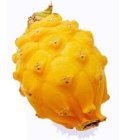Languages
Pitahaya

Pitahayas are cactus fruits. The red pitahaya is round or ovoid, with a diameter of 8-12cm and a weight of 250-450g. When fully ripe, the skin is bright purple red and scaled, the pulp grey-white, very juicy and tastes refreshingly mild-aromatic sweet. It contains approx. 1000 evenly distributed small black seeds which are edible. The fruit has a slight purgative effect, especially if the seeds are chewed. The pitahaya mainly supplies the minerals potassium, phosphor, magnesium, calcium and iron, and some vitamin C as well.
The pitahaya is grown in warm-humid regions. The following varieties are important for the international trade: The „Yellow Pitahaya“ and the „Red Pitahaya“, which is also marketed as "Dragon Fruit".
